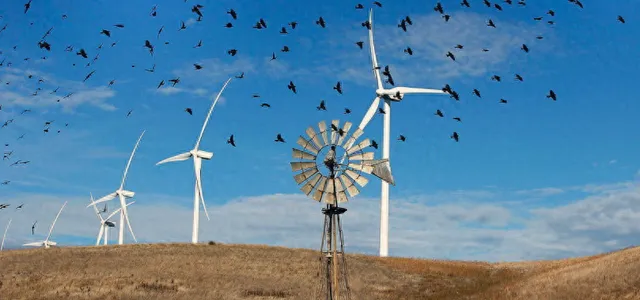原文标题 :
Sharing the skies
Wind turbines are friendlier to birds than oil-and-gas drilling
Contrary to what opponents of wind farms fear
共享天空
风力涡轮机比石油天然气钻井对鸟类更友好
与风电场反对者所担心的正好相反
[Paragraph 1]
BIRDERS GET nervous when they see landscapes covered in wind turbines.
当观鸟者看到风景区被风力涡轮机覆盖时,他们会感到紧张。
When the wind gets going, their blades can spin at well over 200km per hour. It is easy to imagine careless birds getting chopped to bits.
风起时,风力涡轮机叶片的旋转速度远超200公里/小时。不难想象,鸟儿一不小心就会被切成碎片。
Campaigners often point to the possibility when opposing the building of new wind farms.
活动人士在反对建造新的风电场时,经常强调这种可能性。

[Paragraph 2]
No one doubts that wind turbines do indeed kill at least some birds.
当然,风力涡轮机确实造成了一些鸟类死亡,这毋庸置疑。
But a new analysis of American data, published in Environmental Science & Technology, suggests the numbers are negligible, and have little impact on bird populations.
但【环境科学与技术】期刊上发表的美国最新数据分析表明,这些死亡鸟类数字可以忽略不计,对鸟类种群几乎没有影响。
[Paragraph 3]
Wind power has expanded dramatically in America over the past 20 years, from 2.6 gigawatts of installed capacity on land in 2000 to 122 gigawatts in 2020.
过去20年来,美国的风力发电量急剧增长,陆地装机容量从2000年的2.6吉瓦增加到2020年的122吉瓦。
Many studies have analysed the effects in specific locations or on specific bird species. But few have looked at the effects on wildlife at the population level.
许多研究分析了特定地点或特定鸟类的影响。但很少有人研究对野生动物种群水平的影响。
Enter Erik Katovich, an economist at the University of Geneva. Dr Katovich made use of the Christmas Bird Count, a citizen-science project run by the National Audubon Society, an American non-profit outfit.
日内瓦大学的经济学家埃里克·卡托维奇在这方面进行了研究。卡托维奇博士利用了圣诞节数鸟活动的数据,这是一个由美国非营利机构国家「奥杜邦协会」运营的公众科学项目。
Volunteers count birds they spot over Christmas, and the society compiles the numbers. Its records stretch back over a century.
志愿者在圣诞节期间统计他们观察到的鸟类数量,奥杜邦协会负责汇总这些数据。该项目记录可追溯到100多年前。
[Paragraph 4]
Dr Katovich assumed, reasonably, that if wind turbines harmed bird populations, then the numbers seen in the Christmas Bird Count would drop in places where new turbines had been built.
卡托维奇博士进行了合理的假设:如果风力涡轮机对鸟类种群造成危害,那么在建造新涡轮机的地方,圣诞节数鸟活动中看到的鸟类数量就会下降。
He combined bird population and species maps with the locations and construction dates of all wind turbines in the United States, with the exceptions of Alaska and Hawaii, between 2000 and 2020.
他将2000-2020年间美国所有风力涡轮机(阿拉斯加和夏威夷除外)的位置和建设日期与鸟类种群和物种分布图结合起来。
He found that building turbines had no
discernible
effect on bird populations.
他发现建造涡轮机对鸟类数量没有明显影响。
That reassuring finding held even when he looked specifically at large birds like
hawks
,
vultures
and eagles that many people believe are particularly vulnerable to being struck.
甚至当他专门观察鹰隼、秃鹫和老鹰等易受到撞击的大型鸟类时,这一令人欣慰的发现仍然成立。
[Paragraph 5]
But Dr Katovich did not confine his analysis to wind power alone. He also examined oil-and-gas extraction.
但是,卡托维奇博士并没有把他的分析仅仅局限于风力发电。他还研究了油气开采。
Like wind power, this has boomed in America over the past couple of decades, with the rise of
shale
gas produced by
hydraulic
fracturing
, or fracking, of rocks.
与风力发电一样,过去几十年来,随着水力压裂或岩石压裂技术产生的页岩气产量增加,美国的油气开采也蓬勃发展。
Production rose from 37m cubic metres in 2007 to 740m cubic metres in 2020.
产量从2007年的3700万立方米增加到2020年的7.4亿立方米。
[Paragraph 6]
Comparing bird populations to the locations of new gas wells revealed an average 15% drop in bird numbers when new wells were drilled, probably due to a combination of noise, air pollution and the disturbance of rivers and ponds that many birds rely upon.
将鸟类的数量与新天然气井的位置进行比较后发现,钻探新井时鸟类数量平均下降 15%,这可能是由于噪音、空气污染以及许多鸟类赖以生存的河流和池塘受到干扰等综合因素造成的。
When drilling happened in places designated by the National Audubon Society as 「important bird areas」, bird numbers instead dropped by 25%.
当钻探发生在国家奥杜邦协会指定的「重点鸟类区域」时,鸟类数量反而下降了 25%。
Such places are typically migration hubs, feeding grounds or breeding locations.
这些地方通常是鸟类的迁徙中心、觅食地或繁殖地。
[Paragraph 7]
Wind power, in other words, not only produces far less planet-heating carbon dioxide and methane than do fossil fuels. It appears to be significantly less damaging to wildlife, too.
换句话说,风力发电不仅比化石燃料产生更少使地球变暖的二氧化碳和甲烷,而且对野生动物的伤害似乎也小得多。
Yet that is not the impression you would get from reading the news.
然而,如果你读新闻,你可能会得到相反的印象。
Dr Katovich found 173 stories in major American news outlets reporting the supposed negative effects that wind turbines had on birds in 2020, compared with only 46 stories discussing the effects of oil-and-gas wells.
卡托维奇博士发现,2020年美国主流新闻媒体有173篇关于风力发电机对鸟类产生负面影响的报道,而只有46篇报道讨论了石油和天然气井对鸟类的影响。
Wind turbines might look dramatic. But their effect on birds is not.
风力涡轮机可能看起来很引人注目。但它们对鸟类的影响并不大。
(恭喜读完,本篇英语词汇量524左右)
原文出自:2024年1月13日【The Economist】Science & technology版块
精读笔记来源于:自由英语之路
本文翻译整理: Irene
本文编辑校对: Irene
仅供个人英语学习交流使用。
【补充资料】
(来自于网络)
吉瓦是功率单位,符号为GW。1吉瓦=10亿瓦=1 000兆瓦=1百万千瓦。
圣诞节数鸟活动始于1900 年,是北美运行时间最长的公民科学项目。每年在西半球有2000多个地方的人们都会参与其中,帮助收集有关鸟类的信息,了解气候变化如何影响生物多样性。数千名志愿者参与收集的这些数据构成了世界上最大的野生动物调查数据库之一 ,保护生物学家、环境规划师和自然学家们利用这些数据来评估鸟类的种群趋势和分布。
【重点句子】
(3个)
Many studies have analysed the effects in specific locations or on specific bird species. But few have looked at the effects on wildlife at the population level.
许多研究分析了特定地点或特定鸟类的影响。但很少有人研究对野生动物种群水平的影响。
He found that building turbines had no discernible effect on bird populations.
他发现建造涡轮机对鸟类数量没有明显影响。
Wind power, in other words, not only produces far less planet-heating carbon dioxide and methane than do fossil fuels. It appears to be significantly less damaging to wildlife, too.
换句话说,风力发电不仅比化石燃料产生更少使地球变暖的二氧化碳和甲烷,而且对野生动物的伤害似乎也小得多。

自由英语之路











